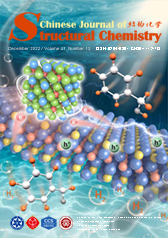
Cover Picture
Ultrathin ZnIn2S4 Nanosheets
Supported Metallic Ni3FeN for Photocatalytic Coupled Selective
Alcohol Oxidation and H2 Evolution
Mengqing Li, Weiliang Qi, Jiuyang Yu, Lijuan Shen, Xuhui Yang, Siqi Liu* and Min-Quan Yang*
Submit a ManuscriptXu-Feng Luo, Jie He, Yang Wang*, Hong Dai* and Zheng-Guang Wu*
Chin. J. Struct. Chem. 2022, 41, 2212070-2212079 DOI: 10.14102/j.cnki.0254-5861.2022-0196
December 2, 2022
helicene, circularly polarized electroluminescence, circularly polarized luminescence, chiral luminescent material, thermally activated delayed fluorescence
ABSTRACT
Benefited from direct generation of circularly polarized (CP) emission with tunable colors, high efficiencies and facile device architectures, CP organic light-emitting diodes (CP-OLEDs) have attracted great attention and are expected to meet industrial applications. Particularly, CP electroluminescence (CPEL) originated from CP-OLEDs has wide potential applications in 3D displays, optical information storage, quantum communication, and biological sensors. The diverse design strategies of chiral luminescent materials for CP-OLEDs, including small organic emitters, lanthanide and transition-metal complexes and conjugated polymers, have been extensively explored. Helicene with twisted extended π-conjugated molecular structure could exhibit special helical chirality and excellent circularly polarized luminescence properties, which has been employed as the ingenious chirality core for constructing efficient chiral luminescent materials. In addition, significant improvements have been made in terms of CP photoluminescence research, however, the development of CPEL with more application prospects in optoelectronic technology still lags behind. In this review, we systematically summarize the recent advances in chiral luminescent materials based on helicene structure and their CPEL properties, including helicene-based chiral fluorescence molecules, transition metal complexes and thermally activated delayed fluorescence molecules, and discuss current challenges and future perspectives for this hot research field. We believe this progress report will provide a promising perspective of OLEDs based on helicene emitters with CPEL properties for extensive researchers, including chemical, physical and material scientists in different disciplinary fields and attract them to this rapidly developing field.







